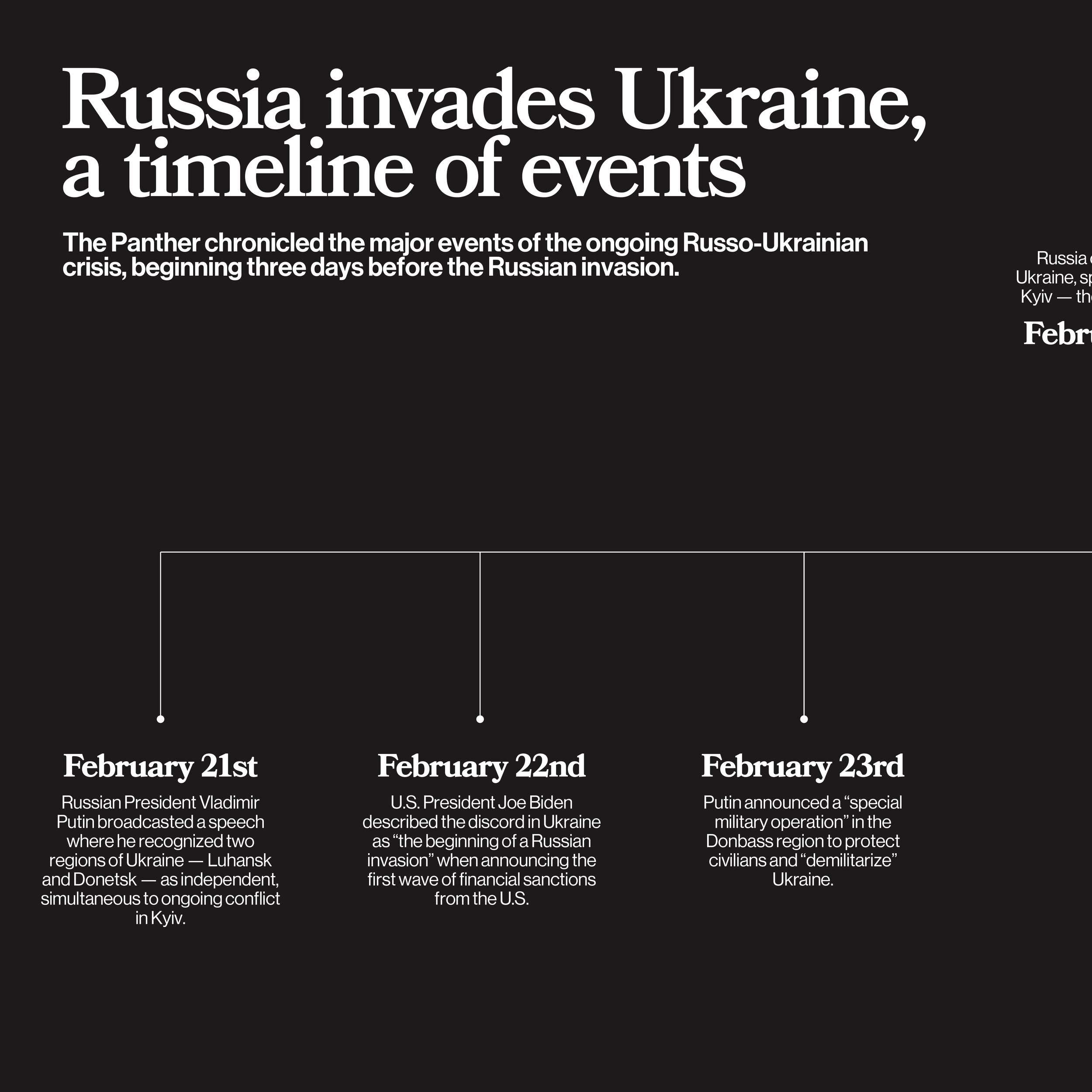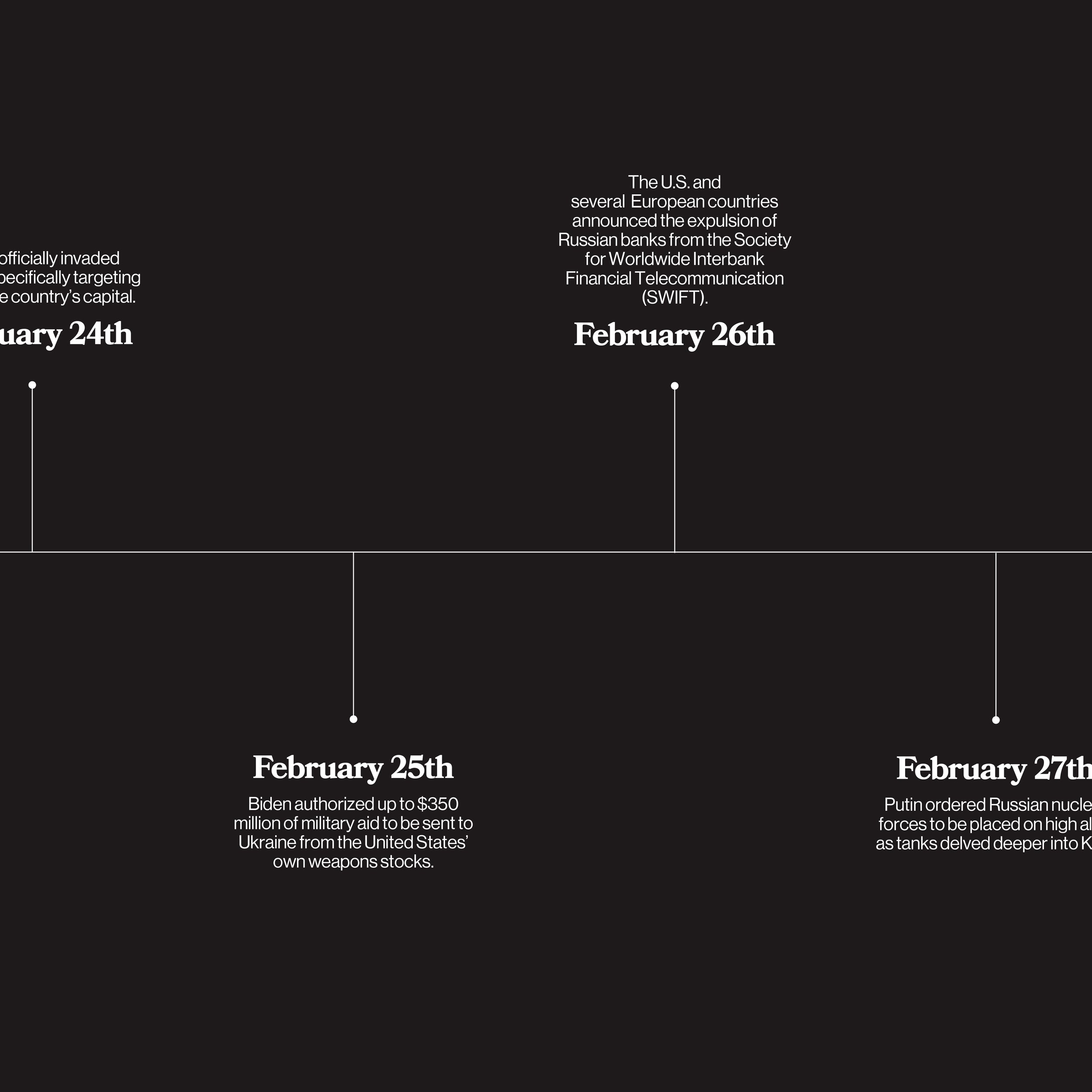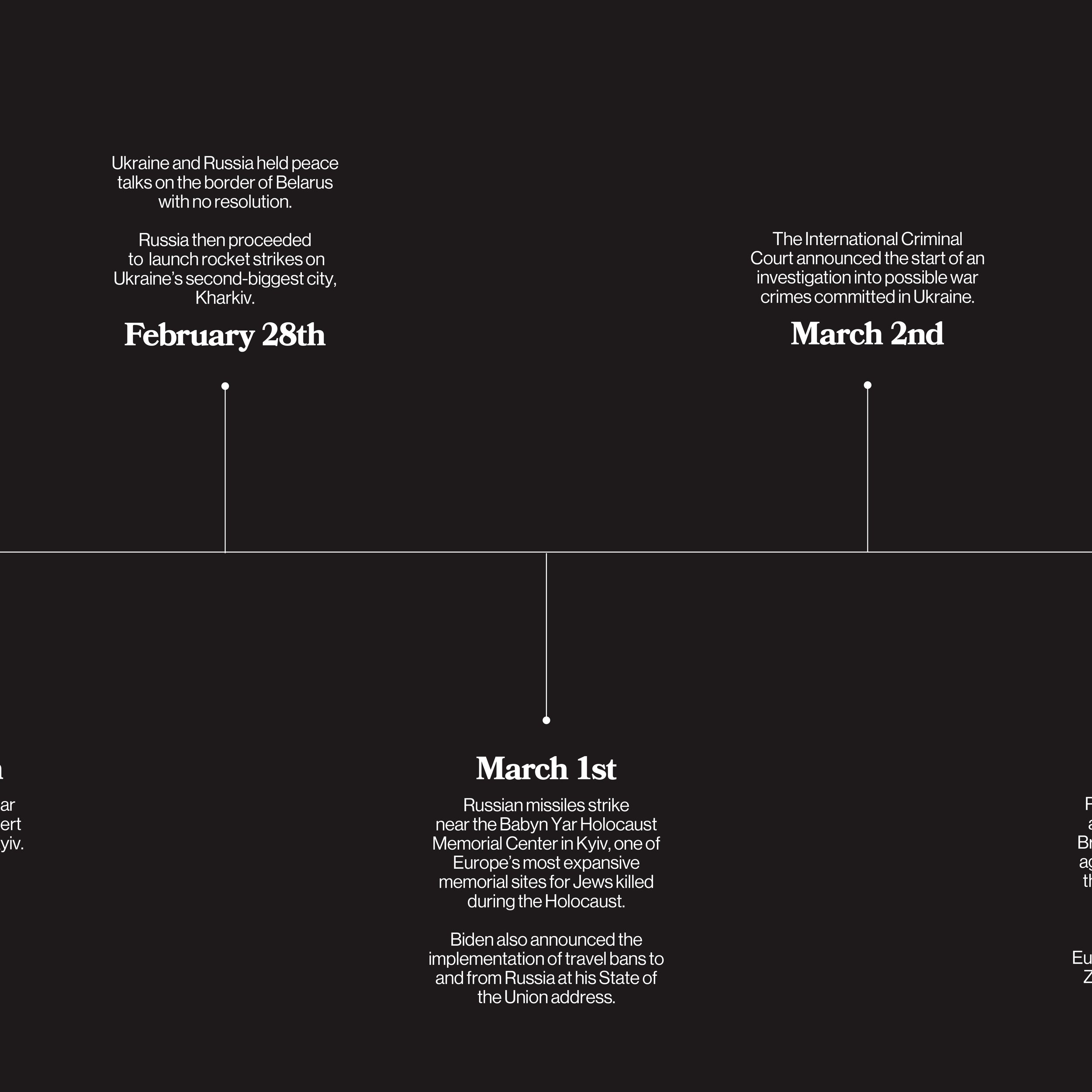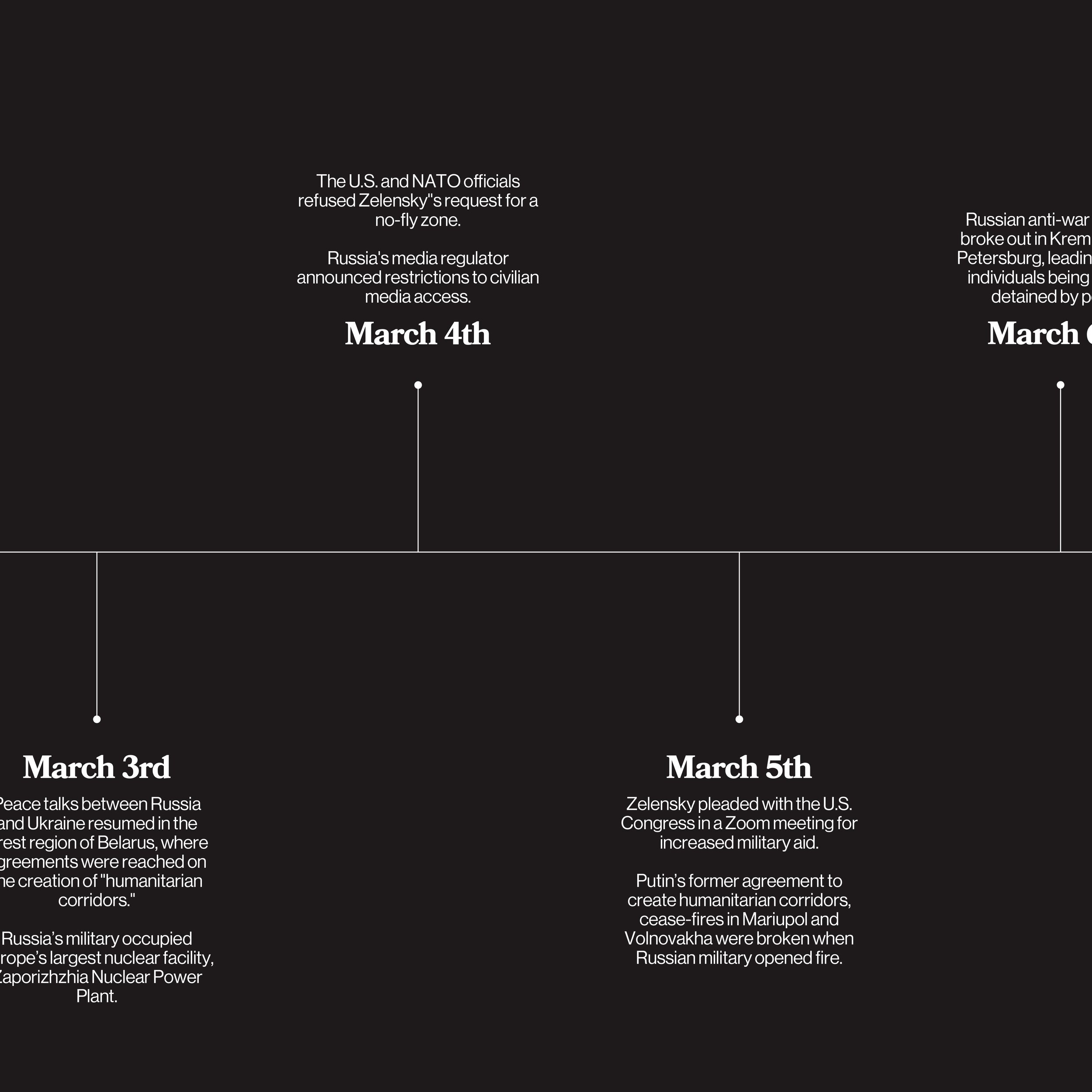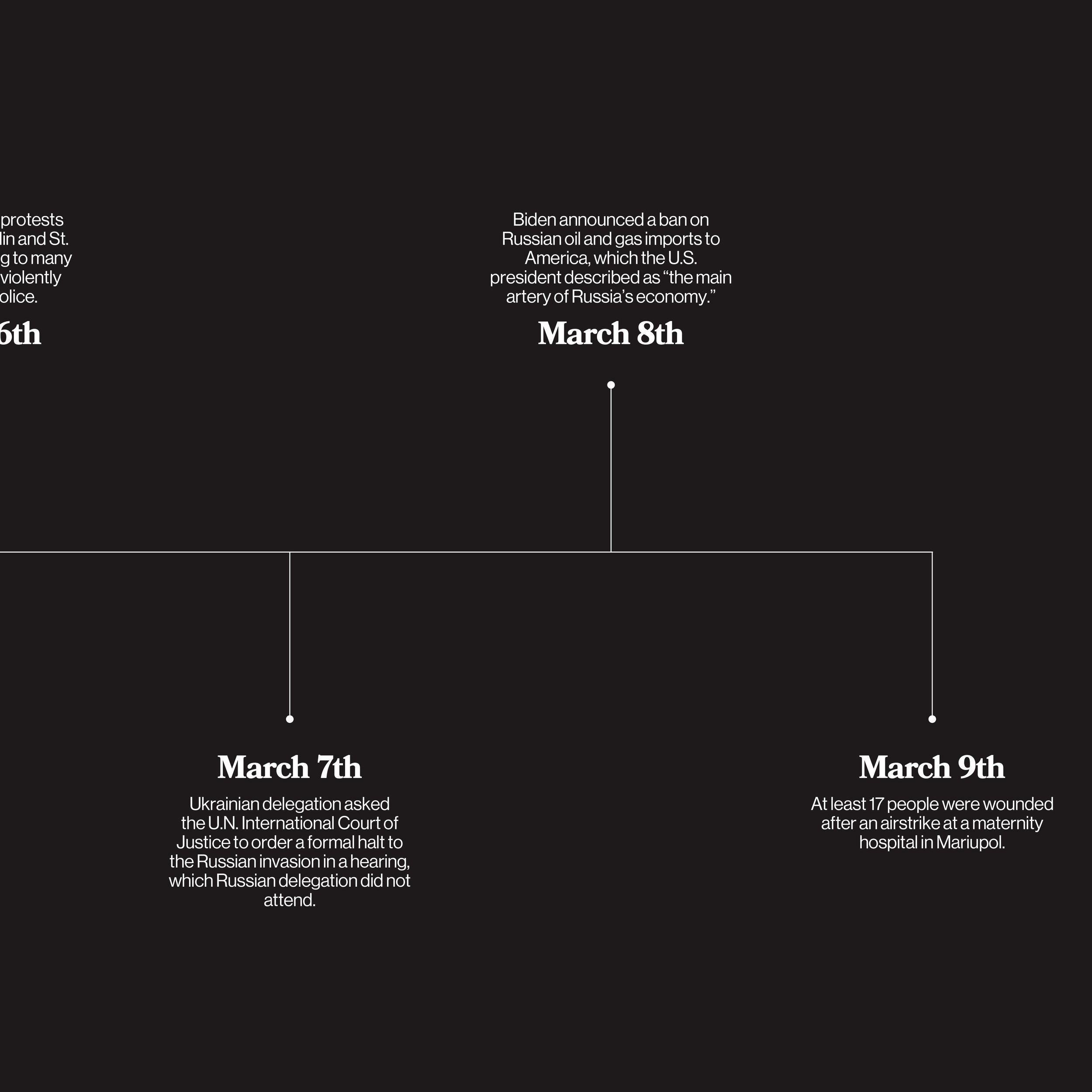Russia invades Ukraine, a timeline of events
Graphic by HARRY LADA, Art Director
After years of conflict between Russia and Ukraine, Russia officially invaded Ukraine Feb. 24. Since then, the war has escalated, taking the form of economic sanctions against Russia, missile strikes on Ukraine, a global paranoia of nuclear explosions and Western countries taking new military measures.
The Panther chronicled the major events of the ongoing Russo-Ukrainian crisis, beginning three days before the Russian invasion:
Monday, Feb. 21
Russian President Vladimir Putin broadcasted a speech where he recognized two regions of Ukraine — Luhansk and Donetsk — as independent, simultaneous to ongoing conflict in Kyiv. Many European leaders criticized this as a breach of international law and a violation of the sovereignty of Ukraine.
In his speech, Putin also expressed his fears of a Western-aligned Ukraine joining the North Atlantic Treaty Organization (NATO), making it easy for the defense organization to launch an attack on Russia. Putin ordered his troops to Donetsk and Luhansk, which have been under the control of pro-Russian rebels since 2014, but he claims Russian military entered the Donbass region to “maintain peace.”
Ukraine responded by calling an emergency meeting of the United Nations Security Council to de-escalate the crisis.
Tuesday, Feb. 22
U.S. President Joe Biden described the discord in Ukraine as “the beginning of a Russian invasion” when announcing the first wave of financial sanctions from the U.S. Other countries also followed suit in declaring bans on trade with Russia like the United Kingdom, Canada, Australia, Japan and the European Union at large.
Germany also halted the certification of the Nord Stream 2 pipeline, which hinders Russia’s ability to export natural gas to Germany.
Wednesday, Feb. 23
Putin announced a “special military operation” in the Donbass region to protect civilians and “demilitarize” Ukraine.
The same day, some of Ukraine’s military airfields and depots were struck by missiles. Ukrainian President Volodymyr Zelensky introduced martial law in the country, as he urged everyone to stay calm in a video address to the nation.
Thursday, Feb. 24
Russia officially invaded Ukraine, specifically targeting Kyiv — the country’s capital. The Russian military launched ground and aerial attacks on several other cities, including Odessa, Kharkiv and Mariupol. In a speech later that day, Putin threatened that any Western countries that tried to interfere with the conflict would face immediate consequences.
Biden announced a new wave of economic sanctions on Russia, with the goal of isolating the nation from the global economy by limiting its ability to do business in dollars, euros, pounds and yen. The Treasury Department released a detailed list of the specific sanctions after Biden’s speech.
The White House also stationed additional troops in Germany to strengthen the defense of NATO allies in Europe.
Friday, Feb. 25
Biden authorized up to $350 million of military aid to be sent to Ukraine from the United States’ own weapons stocks.
Fighting erupted in the streets of Kyiv even among Ukrainians as public officials told citizens to seek shelter. Still, Zelensky refused an offer from the U.S. to be evacuated, saying he felt a sense of duty to remain in his country and fight.
Saturday, Feb. 26
The U.S. and several European countries announced the expulsion of Russian banks from the Society for Worldwide Interbank Financial Telecommunication (SWIFT), a global bank-to-bank payment system. This was the next of a series of sanctions from Western countries to punish Russia for the invasion of Ukraine.
Sunday, Feb. 27
Putin ordered Russian nuclear forces to be placed on high alert as tanks delved deeper into Kyiv, which led to a dramatic escalation of tensions between the sparring nations.
As a result, for the first time in European Union history, the EU announced they would be supplying about 450 million euros ($507 million) worth of weapons to Ukraine.
Monday, Feb. 28
Ukraine and Russia held peace talks on the border of Belarus with no resolution. Both sides returned to their countries for further discussions before meeting for a second time. Russia then proceeded to launch rocket strikes on Ukraine’s second-biggest city, Kharkiv.
The UN refugee agency released an article estimating that over 500,000 people had fled Ukraine into neighboring countries over the last four days since the start of the Russian invasion.
Tuesday, March 1
Russian missiles strike near the Babyn Yar Holocaust Memorial Center in Kyiv, one of Europe’s most expansive memorial sites for Jews killed during the Holocaust. Even though the memorial wasn’t damaged, Zelensky used the attack to rally support for his cause by reminding the world of the atrocities committed in the Holocaust.
Biden addressed the ongoing Russo-Ukrainian crisis in his State of the Union address, where he condemned Putin’s actions and vowed to punish him for threatening democracy in Europe. Biden also announced the implementation of travel bans to and from Russia.
Wednesday, March 2
The International Criminal Court announced the start of an investigation into possible war crimes committed in Ukraine. The investigation will examine conflict in Ukraine from Nov. 21, 2013 — the start of Euromaidan — to present.
Kherson also became the first major city to be taken by Russia. Russian forces imposed a curfew on the city's citizens and only allowed cars carrying food, medicine and other supplies to enter the city.
Thursday, March 3
Peace talks between Russia and Ukraine resumed in the Brest region of Belarus, but the dueling nations didn’t come to a cease-fire agreement. They did manage to agree on creating humanitarian corridors — or areas of temporary ceasefire in order to evacuate civilians.
Russia’s military occupied Europe’s largest nuclear facility, Zaporizhzhia Nuclear Power Plant, marking the first time a country has ever launched an attack on a functioning power plant. During the shelling, a fire sparked, causing concerns of a nuclear explosion worse than Chernobyl. In another video posted by Zelensky, the president urged Russians to remember Chernobyl and accused Putin of blackmailing the world with the threat of nuclear war.
The United Nations Security Council held an emergency meeting after the attack on Zaporizhzhia.
Russia later besieged the port city of Mariupol, where civilians were imposed with restricted access to water, food, electricity and heat.
Friday, March 4
Despite continuous calls from Zelensky for a no-fly zone, the U.S. and NATO officials refused the Ukrainian president’s request out of fear the move could lead to a full-fledged war in Europe.
Russia’s media regulator announced the nation would be blocking civilian access to Facebook and other media outlets — including BBC, Deutsche Welle and Voice of America — for allegedly misinforming on the war in Ukraine.
Saturday, March 5
Zelensky pleaded with the U.S. Congress in a Zoom meeting for increased military aid, which was positively reciprocated from both Democrats and Republicans alike. Despite Putin’s former agreement to create humanitarian corridors, cease-fires in Mariupol and Volnovakha were broken when Russian military opened fire, putting a halt to civilian evacuation efforts.
The U.S. State Department also released a new travel advisory warning U.S. citizens to evacuate the country immediately.
Sunday, March 6
For the second day in a row, Russian forces neglected to uphold their agreement to facilitate humanitarian corridors when they began shooting in Mariupol, forcing civilians trying to evacuate to remain in place.
Russian anti-war protests broke out in the Kremlin and St. Petersburg, leading to many individuals being violently detained by police. The OVD-info monitoring group in Russia released data that over 4,500 people have been detained for participating in these protests since the start of the Russian invasion.
Monday, March 7
Ukrainian and Russian officials met up for a third round of discussions primarily focused on adherence to the implementation of humanitarian corridors. The parties agreed to meet for a fourth time in the coming days.
Anton Korynevych, the head of the Ukrainian delegation, also spoke to the U.N. International Court of Justice in a hearing to order a formal halt to the Russian invasion. However, the Russian delegation did not attend.
Tuesday, March 8
Biden announced a ban on Russian oil and gas imports to America, which the U.S. president described as “the main artery of Russia’s economy.”
Commander of U.S. Strategic Command Adm. Charles Richard, who oversees U.S. nuclear forces, also spoke before the Senate Armed Services Committee at a March 8 hearing where he vocalized concerns about “cooperative aggression” between China and Russia.
Wednesday, March 9
A maternity hospital in Mariupol was besieged in what Zelensky classifies as a “direct strike” from the Russian military. The Ukrainian president posted a video showing a glimpse at the wreckage, which he said some children got caught underneath. At least 17 people were wounded from the airstrike.
Bombs continued falling in Zhytomyr on two other hospitals — one of which was a children’s hospital, though no children were injured. Following the bombings, the World Health Organization confirmed Russia has attacked 18 medical facilities since the start of the invasion.
Katie Reul contributed to this report.

